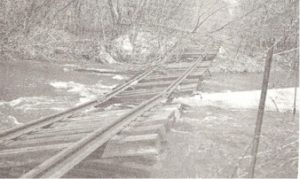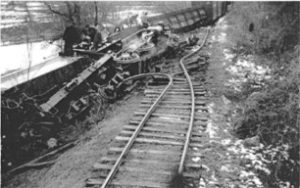Cannon Valley Trail occupies the route of a former Chicago Great Western railroad line that connected Red Wing and Mankato, MN. The line started as the Minnesota Central and in 1882 ![northwestern[1]](https://cannonvalleytrail.com/wp-content/uploads/2016/03/northwestern1-300x120.jpg) construction began easterly from Waterville. It was completed to Red Wing in just over six months with regular service beginning January 1, 1883. The Minnesota Central became part of the Chicago Great Western in 1899, which merged into the Chicago North Western in 1968.
construction began easterly from Waterville. It was completed to Red Wing in just over six months with regular service beginning January 1, 1883. The Minnesota Central became part of the Chicago Great Western in 1899, which merged into the Chicago North Western in 1968.
![railroadpicture[1]](https://cannonvalleytrail.com/wp-content/uploads/2016/03/railroadpicture1-300x129.jpg) In 1983, when the railroad announced its intention of abandonment, the private citizens realized the recreational potential of the line. With the assistance of the Minnesota Parks Foundation (now known as the Parks and Trails Council of Minnesota), they purchased the right-of way with donated funds. They then convinced Cannon Falls, Red Wing, and Goodhue County to manage this rail-trail project with a Joint Powers Board. The Trail was dedicated May 31, 1986, and the asphalt surfacing was completed in 1992.
In 1983, when the railroad announced its intention of abandonment, the private citizens realized the recreational potential of the line. With the assistance of the Minnesota Parks Foundation (now known as the Parks and Trails Council of Minnesota), they purchased the right-of way with donated funds. They then convinced Cannon Falls, Red Wing, and Goodhue County to manage this rail-trail project with a Joint Powers Board. The Trail was dedicated May 31, 1986, and the asphalt surfacing was completed in 1992.
Cannon Valley Trail has a background at least as colorful and full of intrigue as a contemporary soap opera. This story is told in The Chicago Great Western in Minnesota which was published in 1984 based on information made available by the Minnesota Historical Society and several County Historical Societies. The book begins with the origin of The Minnesota Central which was 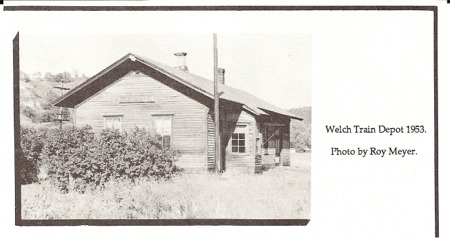 envisioned as a vital transportation link between Red Wing and grain growing areas to the west. The railroad was incorporated in 1857 to build a rail line from Red Wing in the direction of the Great Bend of the Missouri River. Lacking implementation, another enterprise, The Cannon River Slack Water Navigation Company, in 1865 proposed construction of a waterway to Mankato using both the Cannon and LeSueur Rivers plus an intervening series of lakes west of Faribault. An estimate of costs however was sufficient reason to scrap the plan. Construction by the Milwaukee Road during the 1870’s between the Twin Cities and Chicago through Northfield and Faribault had effectively cut off Red Wing as a major grain terminal. This inspired several efforts by Red Wing city officials and business leaders to convince the Milwaukee Road management to build a branch line between Cannon Falls and Red Wing. Such a line, while important to Red Wing, was of little use to the Milwaukee Road since they already had all available business in this area.
envisioned as a vital transportation link between Red Wing and grain growing areas to the west. The railroad was incorporated in 1857 to build a rail line from Red Wing in the direction of the Great Bend of the Missouri River. Lacking implementation, another enterprise, The Cannon River Slack Water Navigation Company, in 1865 proposed construction of a waterway to Mankato using both the Cannon and LeSueur Rivers plus an intervening series of lakes west of Faribault. An estimate of costs however was sufficient reason to scrap the plan. Construction by the Milwaukee Road during the 1870’s between the Twin Cities and Chicago through Northfield and Faribault had effectively cut off Red Wing as a major grain terminal. This inspired several efforts by Red Wing city officials and business leaders to convince the Milwaukee Road management to build a branch line between Cannon Falls and Red Wing. Such a line, while important to Red Wing, was of little use to the Milwaukee Road since they already had all available business in this area.
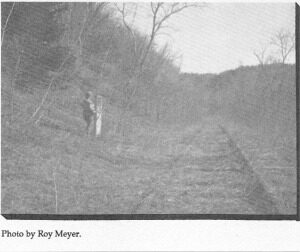
In 1881 under the direction of president, A. B. Stickney, the Minnesota Central became active. He announced the intention of the railroad to complete a line between Red Wing and Waterville in 1882 and to Mankato in 1883. Milwaukee Road reaction was its own announcement of a competing parallel route over the entire distance. Often such a threat would be enough to discourage a new venture because the resources of a large railroad could render the competing line unprofitable forcing it out of business. Treating the announcement as only a threat, the Minnesota Central proceeded with the Red Wing to Mankato line. The level of activity picked up rapidly with both companies courting community leaders along the route for the most favorable location for business and construction. Surveyors for the two companies began work east of Northfield and battle lines were quickly drawn. Local sentiment favored the Minnesota Central, but this did little to discourage Milwaukee Road intimidation efforts. The battle raged throughout the summer of 1882 and was centered in the area of Northfield and Faribault. By fall the lines were at Cannon Falls moving eastward with little conflict because the routes were separated by the Cannon River. The Minnesota Central appeared to have fewer problems along the southern side of the river where the right of way now is occupied by Cannon Valley Trail.
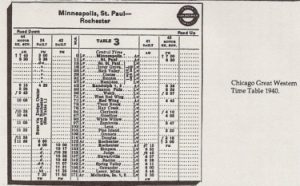 The contest flared anew in downtown Red Wing regarding the rights of both lines to Levee Street. The Milwaukee Road claimed all rights but both the City Council and ultimately the courts decided that the Minnesota Central could also be located on Levee Street. The Cannon Valley Line, as the Minnesota Central came to be known locally, was open for passenger business in January of 1883. By August of the same year it was reorganized under the name of the Wisconsin, Minnesota and Pacific. But in 1884 Chicago Great Western Railroad under A. B. Stickney, established stock control over the Wisconsin, Minnesota and Pacific without changing its name to the Great Western until 1909. Local residents remember a train wreck during this period in the area of the Vasa Township Road “double crossing”. The load of freight upset by the wreck, said to be granite for tombstones still can be observed on the hillside adjoining the Cannon River. The Chicago Great Western was taken over by the Chicago and Northwestern in 1968 but the line was gradually disappearing long before. The last run between Cannon Falls and Red Wing occurred in 1976. The line officially abandoned in 1982 with rail removal following in the fall of 1983.
The contest flared anew in downtown Red Wing regarding the rights of both lines to Levee Street. The Milwaukee Road claimed all rights but both the City Council and ultimately the courts decided that the Minnesota Central could also be located on Levee Street. The Cannon Valley Line, as the Minnesota Central came to be known locally, was open for passenger business in January of 1883. By August of the same year it was reorganized under the name of the Wisconsin, Minnesota and Pacific. But in 1884 Chicago Great Western Railroad under A. B. Stickney, established stock control over the Wisconsin, Minnesota and Pacific without changing its name to the Great Western until 1909. Local residents remember a train wreck during this period in the area of the Vasa Township Road “double crossing”. The load of freight upset by the wreck, said to be granite for tombstones still can be observed on the hillside adjoining the Cannon River. The Chicago Great Western was taken over by the Chicago and Northwestern in 1968 but the line was gradually disappearing long before. The last run between Cannon Falls and Red Wing occurred in 1976. The line officially abandoned in 1982 with rail removal following in the fall of 1983.
Photo by Roy Meyer
Welch Trail Wreck 1912
